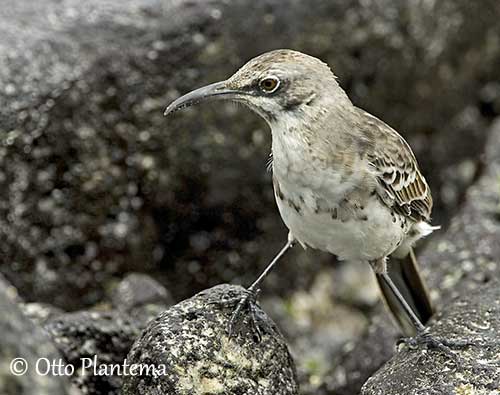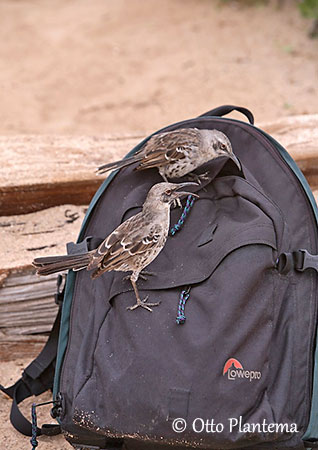
Fr: Moqueur d’Espanola
All: Españolaspottdrossel
Esp: Sinsonte de Española
Ita: Mimo di Espanola
Nd: Españolaspotlijster
Sd: Espanolahärmtrast
Photographers:
John Anderson
John Anderson Photo Galleries
Otto Plantema
Trips around the world
Text by Nicole Bouglouan
Sources:
HANDBOOK OF THE BIRDS OF THE WORLD Vol 10 by Josep del Hoyo-Andrew Elliott-David Christie - Lynx Edicions - ISBN: 8487334725
WRENS, DIPPERS AND THRASHERS by Brewer David – illustrated by Barry Kent Mackay- Yale University Press - ISBN: 0300090595
BirdLife International (BirdLife International)
Wikipedia, the free encyclopaedia
Hood (Espanola) Mockingbird
Mimus macdonaldi
Passeriformes Order – Mimidae Family
INTRODUCTION:
The Hood Mockingbird is endemic to the Galapagos Islands and occurs only on Espanola and Gardner Islands. It is larger than other species. Fearless of humans, it may land on their head or some object, often searching for food and drink.
This species lives in groups of 8-10 birds, sometimes up to 40 individuals. They are territorial, with an established hierarchy within the group.

DESCRIPTION OF THE BIRD:
Biometrics:
Length: 26-28 cm
Weight: M: 76 g – F: 65 g
The adult has scalloped and streaked appearance on the upperparts, with grey to brownish-grey-edged feathers with blackish-brown centres, darker on the hindneck. The rump shows browner edges. The tail is dark brown.
On the upperwing, the wing-coverts are tipped white. The flight-feathers are blackish and white-tipped with tawny edges, like the greater coverts.
The underparts are whitish with diffuse brown markings on the breast, whereas the flanks are streaked.
On the head, we can see a thin whitish supercilium. There is a blackish ear patch and an indistinct malar stripe. The lores are black. The crown is greyish-brown and slightly streaked dark.
The very long decurved bill is blackish. The eyes are yellowish-brown. Legs and feet are black.
Both sexes are similar in plumage, but the female is smaller than male.
The juvenile has more streaked underparts than adults.
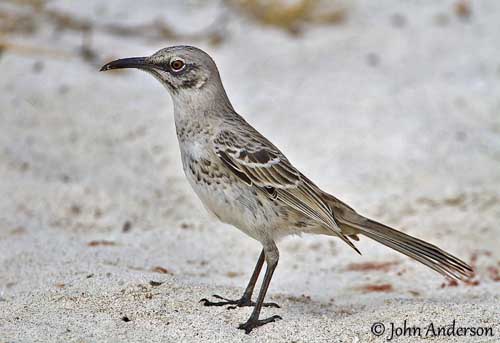
RANGE:
The Hood Mockingbird is found on Espanola and Gardner islands, in SE Galapagos Islands.
HABITAT:
The Hood Mockingbird frequents arid littoral scrubland, scrubby woodland with scattered trees and cacti. It can be seen in seabird colonies too.
CALLS AND SONGS: SOUNDS BY XENO-CANTO
The Hood Mockingbird utters a raucous call and a faint rattle. The song is long and strident, but fairly melodious.
BEHAVIOUR IN THE WILD:
The Hood Mockingbird is omnivorous. The varied diet includes insects, fruits and berries, marine arthropods and small vertebrates. It also feeds on carrion at carcasses of seabirds, lizards and marine mammals. It consumes damaged seabird eggs, but it is also able to open others, thanks to its powerful bill.
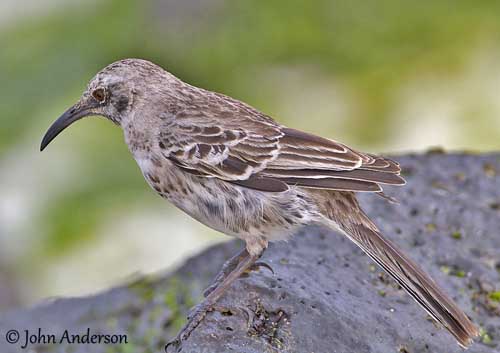
The Hood Mockingbird has developed some peculiar feeding behaviour, especially in dry season: it drinks blood from wounds on living sea lions, from sea lion placentas, on marine iguanas and nestling boobies (Sulidae), by frequenting the hunting areas of the Galapagos Hawk. It removes the ticks and some pieces of dead skin from iguanas, involving sometimes the creation of small wounds from which it drinks the blood.
The Hood Mockingbird has larger and more decurved bill than other Mimidae species, allowing the bird to perform this type of feeding behaviour.
The Hood Mockingbird lives in groups of 8-10 adults where there is usually one breeding pair. They are territorial and the group defends a territory.
There is an established hierarchy within the group. A typical behaviour, a begging display indicating submission, maintains this hierarchy.
Such groups are usually larger when the territory includes a shoreline area. The size averages 1, 5 hectare.
They are co-operative breeders, with non-breeding members helping in territory defence and nesting duties. They can be extremely aggressive.
They occur in larger groups of up to 40 individuals outside the breeding season.
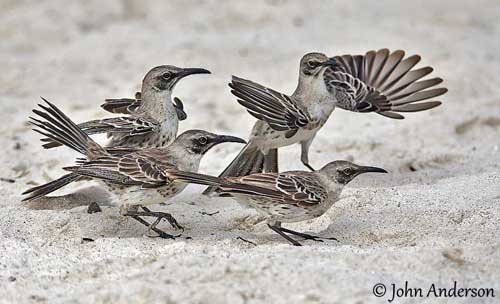
The Hood Mockingbird is sedentary, only performing short-distance flights between groups.
REPRODUCTION OF THIS SPECIES:
The breeding season takes place in February-April.
The cup-shaped nest is placed in cactus or sometimes in shrub. It is made with twigs, and lined with softer materials.
The female lays 2-4 eggs, sometimes only one. Several adults can feed the chicks.
No more information available.
PROTECTION / THREATS / STATUS:
The Hood Mockingbird has very restricted range where it is common. The population is estimated at 600/1.700 mature individuals.
The species is threatened by introduction of pest species (rats), parasites and diseases, but currently, none of these pests are present.
However, due to the restricted range, this species is classified as Vulnerable.
